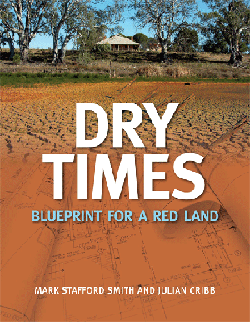
|
Published:
Lessons from living on the edge

|
|
Dry Times: Blueprint for a Red Land Mark Stafford Smith & Julian Cribb CSIRO Publishing 2009, Softcover ISBN: 9780643095274 – AU$49.95 www.publish.csiro.au |
Ignore the survival and adaptation strategies of desert inhabitants at our peril is the theme of Dry Times: Blueprint for a Red Land. This book, by Mark Stafford Smith and Julian Cribb, provides new insight into how desert environments and desert institutions work – and how desert knowledge can help us cope with highly variable resources.
Although deserts have been drivers of human innovation for millennia, they are unpredictable places; remote, scarce in resources and regarded with fear or disdain by non-desert dwellers. Yet the inhabitants of deserts display remarkable adaptations to help them cope – and thrive -– in an uncertain environment. They range from daisies whose seeds lie dormant for years before germinating in winter rains, yet holding some seed back for decades as an insurance policy; to multiple lizard species that share resources in a single spinifex clump by foraging at different times of the day; to nomadic humans that build strong community ties, yet move readily when the going gets tough; and the adaptability of desert businesses and agricultural enterprises.
Deserts offer models for successful adaptation and management that apply equally to business, government and community leadership, and solutions to the challenges of living with uncertainty. But the adaptability, mobility and resource husbandry necessary for desert survival doesn’t fit well with policies developed for more stable environments, and rules that apply to businesses in good times don’t work in the bad.
As the world’s farming lands and savannahs dry up and water becomes scarcer thanks to climate change and mismanagement, the future of the world as we know it and its resources are becoming less certain, scarcer and more unpredictable – more like deserts in fact.
In the face of an uncertain future, Dry Times argues that we would do well to turn again to the wisdom embodied in desert knowledge and find answers to the increasingly pressing challenges of scarcity, uncertainty and aridity that face us all.



